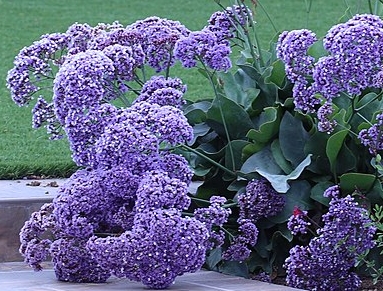
Also known as marsh rosemary and sea foam, this herbaceous perennial is native to the coasts of the Canary Islands but is valued as a garden plant worldwide. It is a member of the leadwort family, Plumbaginaceae, that also includes thrifts. The plant grows up to 3′ tall and has a woody rhizome that forms a basal rosette of leathery, oval to round leaves with long petioles and wavy margins. The leaf blade is 1.5-6″ long, 1-2 3/4″ wide, and pinnately veined. From spring through summer, stiff, branching reddish stems up to 18′ long bear 8″ wide domed clusters of small flowers with white petals and lavender, papery sepals that resemble petals. The flowers are attractive to butterflies, dry well and are beautiful in dried and fresh arrangements. The plants are tolerant of heat, drought, salt spray ,and wind so are an excellent choice for seaside gardens as well as for xeriscapes, containers, and butterfly and rock gardens. The genus name, Limonium, is from the ancient Greek word λειμών (leimṓn) meaning meadow, referring to the habitat of many species. The specific epithet, perezii, honors Dr. George V. Perez, a medical doctor who sent seed of several different statice species to Kew in 1902.
Type: Herbaceous perennial
Bloom: Domed clusters of small flowers with white petals and purple sepals from spring through summer
Size: 2-3′ H x 2-3′ W
Light: Full sun
Soil: Sand to loam, dry to moderately moist, well-drained, neutral to alkaline
Hardiness: Zones 10-11
Care: Remove old leaves before new ones appear and dead flower stalks as they appear; divide every 2-3 years to maintain vigor
Pests and Diseases: Generally healthy but susceptible to root rot, crown rot, rust, scale and nematodes
Propagation: Seed
Companion Plants: Artemesia spp, parrot’s beak, blue Festuca
Outstanding Selections: None available
Photo Credit: SGS Wikimedia Commons